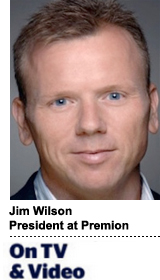 “On TV And Video” is a column exploring opportunities and challenges in advanced TV and video.
“On TV And Video” is a column exploring opportunities and challenges in advanced TV and video.
Today’s column is written by Jim Wilson, president at Premion, a division of Tegna Inc.
It has been a pivotal year for over-the-top (OTT) advertising. Advertisers are following the eyeballs, and significant ad dollars are shifting from cable to OTT.
In the past year, we’ve seen new advancements in OTT targeting capabilities. OTT now combines the best of TV with the ability to precisely target viewers down to the ZIP-code level, based on demographics, lifestyle and interests.
New advanced analytics tools are also helping brands and agencies buy the audience and inventory they really want and better quantify OTT campaign results. For example, Nielsen and comScore are making more headway in providing reach, frequency and GRP measurement for OTT at the campaign level.
But despite great progress, our industry will need to drive toward standardization for OTT advertising to truly scale: We need to agree on and create unified measurement standards.
Without the ability to leverage historical data, which is available in digital media or standardized metrics, some advertisers and marketers hesitate to allocate greater OTT advertising spend.
Unlike digital advertising, connected TVs do not have cookies. This means that OTT targeting must be done via tags to IP addresses. In a cookieless environment, the data is there to be collected.
However, connected devices gather different types of data, which require more in-depth analysis and extensive matching using third-party data to complete viewer profiles. New capabilities are emerging to target users through a device ID that allows advertisers to leverage their first-party data or a data management platform to reach its identified audiences.
Since OTT does not have its own specific guidelines and protocols, agencies often try to apply to OTT the digital measurement standards for third-party tracking, viewability, invalid traffic and other KPIs. However, digital measurement solutions weren’t designed to incorporate OTT viewing.
Our OTT ecosystem of content providers, publishers and ad tech companies must work together to address agencies’ and clients’ concerns about measurement and transparency in three key areas: third-party tracking, viewability and VAST vs. VPAID, the IAB specifications for serving video ads.
All of this requires the adoption of a standardized token of measurement. Measurement companies, such as Nielsen, comScore, MOAT and IAS, must also continue encouraging publishers and advertisers to solve for the fragmentation within OTT and agree on industry standards.
The governing bodies of the IAB and MRC must also support and drive the industry toward standardization. Specifically, they should set and govern impact metrics, such as viewability, fraud monitoring and completion rates.
Marketers and agencies will need to set clear expectations on OTT spend and identify which solutions offer the biggest ROI on the impact metrics that matter. Having alignment on the KPIs and metrics for measuring success is key for instilling greater advertiser confidence in OTT media spend.
Another industry development that has the potential to drive standardization is blockchain. Blockchain offers tremendous potential to reduce fraud and costs in the advertising supply chain. By leveraging a decentralized network, advertisers can better align ad campaign KPIs, such as delivery, billing and viewability. Specifically, AdLedger, the blockchain consortium, is working to educate and help bring increased transparency and data security to the ad tech supply chain.
The future of television will be over the internet, and advertisers are already seizing the opportunities with the shifting consumer viewing habits. Together, all players can pave the way forward with greater collaboration with partners and greater investment in new capabilities to improve the standardization and delivery of advanced targeting and engagement for advertisers.
Follow Premion (@PremionMedia) and AdExchanger (@adexchanger) on Twitter.
This post was syndicated from Ad Exchanger.

More Stories
The Tuesday Club hosts Women’s Work’s In(visible) exhibition in Tāmaki Makaurau
Under Armour Taps Estée Lauder Exec to Lead AI and Analytics
Lani Jamieson joins D3 to shape the next chapter of its growth